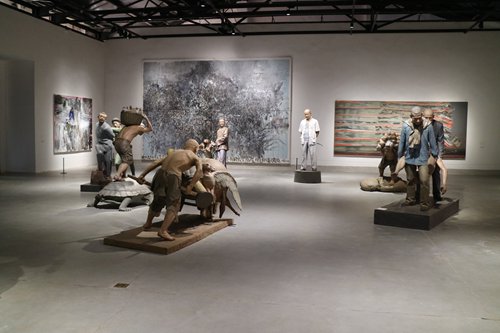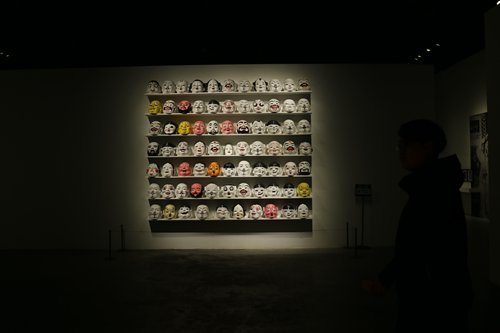
Part of Chinese artist Li Zhanyang's series of statues, Rent-Rent Collection Courtyard, on display at the Anren Biennale Photo: Huang Tingting/GT
While Anren, Southwest China's Sichuan Province, has long been famous for its delicious culinary dishes made from chilled pig's blood and residences that once belonged to famous figures in Chinese history, the 1,000-year-old town is looking to a new attraction to bring in tourists - modern art.
The first Anren Biennale, which kicked off in late October and runs until February 2018, is hosting hundreds of artworks ranging from paintings to installations created by modern artists from more than 20 countries and regions.
Renowned curators from home and abroad assembled to pack the local factory-turned-venue with avant-garde art pieces from big-name artists such as Zhang Xiaogang and Chen Danqing. But why choose a suburban town instead of a major metropolis as so many other recent domestic biennales have done?
While Anren is an ancient town, it actually has a closer connection to modern art than people may think, considering it is the birthplace of the Rent Collection Courtyard, a group of controversial clay sculptures made in 1965. Tackling the themes of oppression and resistance, the artwork remains one of China's most well-known modern artworks today.
"Rent Collection Courtyard and the town's other historical sites and resources served as major sources of inspiration for this exhibition and its theme," said Lü Peng, the exhibition's general curator, at a press tour for the exhibition on December 18.
Taking "Today's Yesterday" as its theme, the exhibition aims to discuss the bonds and influences that tie the present and the not-too-faraway past together - a major task that all modern art should undertake, Lü noted.
A local affair
The exhibition is divided into four sections - Rhetoric of Genealogy, Crossroads, The Szechwan Tale: Theatre and History, and A Future that Never Returns.
"We've tried to make the Anren Biennale more 'local' rather than 'international,' which is what many other Chinese biennales are trying to be," Lü explained.
"We are not talking about reviving local traditional culture, but rather asking questions about the ties that exist between modern society and our local heritage."
The section that best unites local characteristics with art is definitely The Szechwan Tale: Theatre and History curated by veteran Italian curator Marco Scotini. Drawing on Rent Collection Courtyard and German playwright Bertolt Brecht's The Good Person of Szechwan for inspiration, Scotini turned the venue into a giant theater featuring impressive dramatic elements including a wall of smiling masks titled Greeting by Chinese artist Qiu Zhijie, racks of costumes ranging from Peking Opera outfits to "Mao" suits in Memory/Wardrobe designed by Italian artist Michelangelo Pistoletto and a number of video and installation works of various styles.
"Scotini did a lot of research before putting together this show, which is very innovative and refreshing," Lü said.
Also on display are a number of works from Chinese artists born during the 1950s and 1960s that show an obvious connection to China's revolutionary past, especially the Cultural Revolution (1966-76). From He Gong's installation Long Live Thatched Shelter to Jing Kewen's Cloudless series of paintings, visitors will find countless classic symbols of revolutionary history such as the Red Guards' grass green uniforms, rooftop loudspeakers and melodies from famous red songs.
Moreover, Sui Jianguo's breathtaking 3-meter-high sculpture Inheritance and Li Zhanyang's Rent-Rent Collection Courtyard, inspired by the 1965 sculptures, explore the impact that China's revolutionary heritage has had on society today.
It's not just Chinese artists that are exploring revolutionary history, foreign artists such as William Kentridge from South Africa and Pedro Reyes from Mexico are also dipping their toes in this area by sharing their video works Notes Towards a Model Opera and Baby Marx.
Lü told the Global Times that this deep dive into revolutionary history was not deliberate or planned ahead of time by the curators.
"Artists were free to create anything they felt reflects the theme. Naturally, different artists have different understandings of this theme," he said.
Modern perspectives
Different from the older generation, Chinese artists of China's Post-1980 generation taking part in the biennale seem to prefer to focus more on personal feelings, such as Li Qing with his bloody and quirky video Sweet Statue - Pushkin in Shanghai and Qiu Hongfeng with his oil painting Shenyang Smeltery in 2002, which combines the artist's nostalgic childhood memories with the decline of heavy industrial bases in Northeast China.
"It is typical for young [Chinese] artists to observe things in a more microscopic way," Lü noted, pointing to Ma Haijiao's Yesterday's Paper Telling Yesterday's News, an instillation work made up of old postcards filled with handwritings.
On the other hand, many foreign artists at the exhibition are leaning toward a more macroscopic view, delving into today's global turmoil including religious conflicts, the immigrant crisis and war. Artwork in this vein includes Slovakian artist Tomáš Rafa's video work that features angrily roaring people taking part in protests in Europe as well as paintings about the horrors of war from Spanish painter Daniel García Andújar.
Experimental projects are also must-see stops at the exhibition, including Xu Bing's The Dragonfly Eye, an interesting 81-minute feature film pieced together using footages from public surveillance cameras that the artist says "reveal the invisible crises hidden in our mundane lives."

Qiu Zhijie's Greeting Photo: Huang Tingting/GT

Character No.6 and Character No.11 by Guo Wei Photo: Huang Tingting/GT


